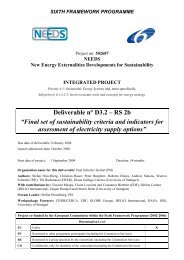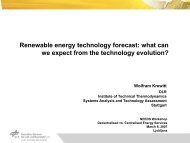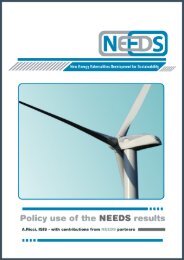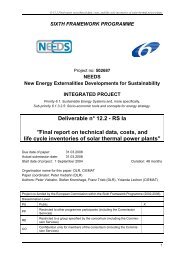Generation, of the energy carrier HYDROGEN In context ... - needs
Generation, of the energy carrier HYDROGEN In context ... - needs
Generation, of the energy carrier HYDROGEN In context ... - needs
Create successful ePaper yourself
Turn your PDF publications into a flip-book with our unique Google optimized e-Paper software.
NyOrka Page 21 12/18/20084.1 Hydrogen roadmaps and policyThe 2003<strong>energy</strong> policy paper: European Energy Outlook and Transport – Trends to 2030states that fossil-fuel prices are foreseen to be static and <strong>the</strong>refore conventional fuel fortransport i.e. oil products are considered to keep <strong>the</strong>ir market share. Hydrogen is nei<strong>the</strong>rmentioned for use in stationary application, CHP nor as fuel for transport 17 . Some <strong>of</strong> <strong>the</strong>Trend paper’s assumptions, such as price for oil, became highly inaccurate only 3 yearsafter its publication.<strong>In</strong> 2002 <strong>the</strong> European Commission launched a policy outline regarding hydrogenspecifically for Europe 18 . Hydrogen is linked to hopes for a more <strong>energy</strong>-self reliantEurope and its policies to decrease carbon emissions and leverage <strong>the</strong> risk <strong>of</strong> climatechange by increasing <strong>the</strong> use <strong>of</strong> renewable local <strong>energy</strong>. Referring to Error! Referencesource not found. it becomes evident that <strong>the</strong> outlined idea is to derive hydrogen fromvarious sources, ei<strong>the</strong>r <strong>energy</strong> <strong>carrier</strong>s with carbon contents or from water throughelectrolysis. Carbon sequestration is discussed in <strong>the</strong> same <strong>context</strong>, if H 2 is madecentrally from fossil fuels such as gas.The EC supported HyWays 19 project (2005– 2007) suggest that <strong>the</strong> maximum penetrationtarget for hydrogen and fuel cell passenger cars in 2020 should be 3% <strong>of</strong> <strong>the</strong> totalpassenger car fleet. Car- manufacturers (for example GM in USA, Toyota in Japan,Daimler in Europe) state that <strong>the</strong> technological maturity for marketable FC vehicles willhave arrived by 2010 but o<strong>the</strong>rs 20 aim to <strong>of</strong>fer a different type <strong>of</strong> hydrogen drive trainusing high heat fuel cells by 2020. Still o<strong>the</strong>rs manufacture vehicles for public transportthat burn hydrogen in internal combustion engines. These vehicles will have integratedbattery and hydrogen drive trains to raise efficiency, as will o<strong>the</strong>r types <strong>of</strong> vehicles usingdifferent <strong>energy</strong> <strong>carrier</strong>s derived from renewable sources.<strong>In</strong> 2006 <strong>the</strong> European Commission issued a green paper listing a number <strong>of</strong> options forachieving sustainable competitive and secure <strong>energy</strong> supplies in <strong>the</strong> EU 21 assuming thathydrogen will be available on <strong>the</strong> market both as fuel for vehicles and as a buffer inelectric systems that are (partially) powered by renewable <strong>energy</strong> such as connectedwindfarms. By December 2006 scientists urged <strong>the</strong> European commission as well asgovernments and <strong>the</strong> UN to consider supportive measures to aid <strong>the</strong> introduction <strong>of</strong>hydrogen worldwide and a developmental centre whose goal is to facilitate <strong>the</strong>introduction <strong>of</strong> hydrogen in developing countries is in Turkey, a country that aims tobecome part <strong>of</strong> EU.The use <strong>of</strong> hydrogen in <strong>the</strong> transport sector will influence <strong>the</strong> speed <strong>of</strong> integration intostationary applications and technological spill-over will influence stationary applications.Current transportation <strong>of</strong> hydrogen in pipes as is already known from central Europe will17 European Commission Directorate-General for Energy and Transport, 2003: European <strong>energy</strong> and transport trends to2030. Prepared by National Technical University <strong>of</strong> A<strong>the</strong>ns, E3Mlab18 EC 2003, High level group to <strong>the</strong> commission: Hydrogen and fuel cells a vision <strong>of</strong> our future19 A brief description <strong>of</strong> <strong>the</strong> project, its goals and tools is given at: www.hyways.de/project/description.html20 Volkswagen, nov 200621 EurActiv EU news, policy positions and EU Actors online; 9th <strong>of</strong> March www.euractiv.com/Article?tcmuri=tcm:29-153252-16&type=News







